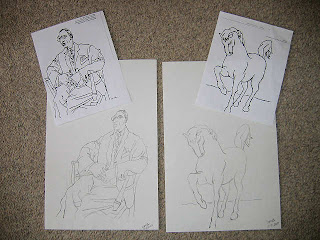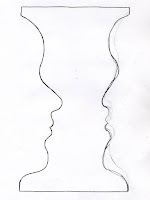
Today's drawing lesson revolved once again on getting your left brain to get out of the way. We copied the line drawings you see above, but not how you might expect. The photocopy was turned upside down and covered except for the inch or so we were currently working on. Your brain can't quite figure out what it is you are trying to draw, so you focus on spatial relations instead. It also shows how important it is to break a task into smaller parts. - something I know from my quilting experience. Otherwise the brain may get overwhelmed by all the information feeding into it. The sitting man was my first attempt. When I spun the finished drawing right side up, I laughed to see what a pinhead I'd drawn! I knew I'd started out a bit wider than I should have, and instead of keeping the proportion, I just kept sizing it in as I moved down. I did much better with the horse.
 We also did this exercise for drawing a mirror image. The left part of the vase was on the paper. The shape is also the shape of a face in profile. Trace over the lines saying each part as you move over it: forehead, eye, nose, upper lip, lower lip, chin. Now draw the same shape in reverse to complete the right side of the face, repeating the parts of the face as you draw them. For right handed people, this is difficult - the right hand being controlled by the left side of the brain. Our single left handed student breezed right through this, saying it was easy compared to the upside down drawing. The rest of us felt the frustration. Apparently, by focusing on the fact that the vase is shaped like a face, the left brain tries to take over because it thinks it knows exactly what a face should look like but does a poor job of relating it out the end of the pencil. I found my instinct was to echo, not mirror the shape. Keeping one eye on the shape I was mirroring, I'd get confused about which direction the curve I was drawing was supposed to go. I actually did better when I forgot about the left side and focused on what part of the face I was drawing. I drew from top to bottom, and actually erased and did it again, with better results. Then I traced from bottom to top and felt perhaps I would have done even better had I done my drawing that direction.
We also did this exercise for drawing a mirror image. The left part of the vase was on the paper. The shape is also the shape of a face in profile. Trace over the lines saying each part as you move over it: forehead, eye, nose, upper lip, lower lip, chin. Now draw the same shape in reverse to complete the right side of the face, repeating the parts of the face as you draw them. For right handed people, this is difficult - the right hand being controlled by the left side of the brain. Our single left handed student breezed right through this, saying it was easy compared to the upside down drawing. The rest of us felt the frustration. Apparently, by focusing on the fact that the vase is shaped like a face, the left brain tries to take over because it thinks it knows exactly what a face should look like but does a poor job of relating it out the end of the pencil. I found my instinct was to echo, not mirror the shape. Keeping one eye on the shape I was mirroring, I'd get confused about which direction the curve I was drawing was supposed to go. I actually did better when I forgot about the left side and focused on what part of the face I was drawing. I drew from top to bottom, and actually erased and did it again, with better results. Then I traced from bottom to top and felt perhaps I would have done even better had I done my drawing that direction.
The final exercise was to very slowly draw the lines on a crumpled piece of paper without looking away from it, i.e. without looking at the pencil while drawing. Supposedly this will bore the left brain, and let the right brain take over. I found I was almost immediately in the zone, while other found it hard to shut off their left brain.
There was one more exercise but we had run out of time, so will complete it next week. The time really does fly in this class, and I am finding it a great change of pace. I'm still pondering the why of my subconscious actions. Is there a reason I keep choosing to draw my hand palm up instead of palm down? And how much does my quilting experience factor in on how well I do on the exercises. During the upside down drawing, I felt maybe I had an edge because my eyes are already trained to see spatial relationships. I wondered if the mirror drawing was partly difficult because I do so much echo quilting, not shapes that mirror themselves.
 We also did this exercise for drawing a mirror image. The left part of the vase was on the paper. The shape is also the shape of a face in profile. Trace over the lines saying each part as you move over it: forehead, eye, nose, upper lip, lower lip, chin. Now draw the same shape in reverse to complete the right side of the face, repeating the parts of the face as you draw them. For right handed people, this is difficult - the right hand being controlled by the left side of the brain. Our single left handed student breezed right through this, saying it was easy compared to the upside down drawing. The rest of us felt the frustration. Apparently, by focusing on the fact that the vase is shaped like a face, the left brain tries to take over because it thinks it knows exactly what a face should look like but does a poor job of relating it out the end of the pencil. I found my instinct was to echo, not mirror the shape. Keeping one eye on the shape I was mirroring, I'd get confused about which direction the curve I was drawing was supposed to go. I actually did better when I forgot about the left side and focused on what part of the face I was drawing. I drew from top to bottom, and actually erased and did it again, with better results. Then I traced from bottom to top and felt perhaps I would have done even better had I done my drawing that direction.
We also did this exercise for drawing a mirror image. The left part of the vase was on the paper. The shape is also the shape of a face in profile. Trace over the lines saying each part as you move over it: forehead, eye, nose, upper lip, lower lip, chin. Now draw the same shape in reverse to complete the right side of the face, repeating the parts of the face as you draw them. For right handed people, this is difficult - the right hand being controlled by the left side of the brain. Our single left handed student breezed right through this, saying it was easy compared to the upside down drawing. The rest of us felt the frustration. Apparently, by focusing on the fact that the vase is shaped like a face, the left brain tries to take over because it thinks it knows exactly what a face should look like but does a poor job of relating it out the end of the pencil. I found my instinct was to echo, not mirror the shape. Keeping one eye on the shape I was mirroring, I'd get confused about which direction the curve I was drawing was supposed to go. I actually did better when I forgot about the left side and focused on what part of the face I was drawing. I drew from top to bottom, and actually erased and did it again, with better results. Then I traced from bottom to top and felt perhaps I would have done even better had I done my drawing that direction.The final exercise was to very slowly draw the lines on a crumpled piece of paper without looking away from it, i.e. without looking at the pencil while drawing. Supposedly this will bore the left brain, and let the right brain take over. I found I was almost immediately in the zone, while other found it hard to shut off their left brain.
There was one more exercise but we had run out of time, so will complete it next week. The time really does fly in this class, and I am finding it a great change of pace. I'm still pondering the why of my subconscious actions. Is there a reason I keep choosing to draw my hand palm up instead of palm down? And how much does my quilting experience factor in on how well I do on the exercises. During the upside down drawing, I felt maybe I had an edge because my eyes are already trained to see spatial relationships. I wondered if the mirror drawing was partly difficult because I do so much echo quilting, not shapes that mirror themselves.
No comments:
Post a Comment